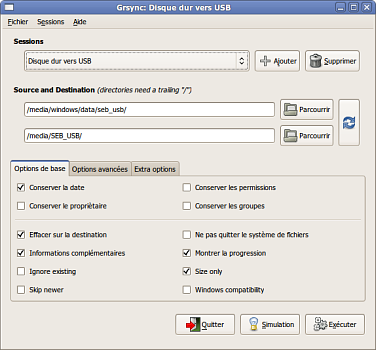
Timeshift is an open-source powerful backup and system restore tool for Linux that requires little setup.
#Install grsync ubuntu install#
To install Grsync on your system, simply run the following command: $ sudo apt install grsync Grsync – Backup and File Synchronization Tool It comes with an efficient interface and supports the storage of different sessions (you can create and switch between sessions). It currently supports only a limited set of the most important rsync features, however, it can be used effectively to synchronize directories, files, and make backups. Grsync is an open-source simple, great, and easy to use graphical user interface for the popular rsync command-line tool. This requires you to have snapd package installed on your system.

To install Déjà Dup in Ubuntu and Linux Mint, open a terminal window and run the following command: $ sudo apt install deja-dupĪlternatively, you can also install it as a snap as follows. It also features incremental backups that allow you to restore from any particular backup, schedules regular backups, and integrates well with GNOME desktop environment. It securely encrypts data for safe transactions and compresses data for faster transmission. It supports local, off-site (or remote), or cloud backup locations such as Google drive. It uses duplicity (encrypted bandwidth-efficient backup using the rsync algorithm) as the backend. Déjà Dupĭéjà Dup is an open-source simple yet powerful personal backup tool that makes backup incredibly easy. These Linux backup tools are also installable and work on Ubuntu flavors such as Lubuntu, Kubuntu, and Xubuntu and other derivatives such as elementary OS, Zorin OS, and more. (thread from KDE's forum.In this guide, we review the best graphical user interface backup tools for Ubuntu and Linux Mint operating systems. (expains how rdiff-backup works comparing it to rsync) No nice ones for rdiff-backup though.Īnd there's storebackup too, but i don't know that much about it.Īnyway, i just think the most important information for me, regarding backup tools, is what happens to the data, what file structure, how can i browse it and retrieve files / restore backups.Ī few interesting links in my huge bookmarks list. Tools such as Back In Time or Flyback, modeled after Apple's Time Machine (like Ubuntu's TimeVault - unrelated to rsync i think). This saves data, at the cost of a little more complexity, since you can't browse the old snapshots easily with a file browser, only with special tools or rdiff-backup itself. Rdiff-backup creates a mirror for the latest backup, but previous snapshots are kept as "deltas" (the reverse of what you'd expect from a differential backup), which contain information for rdiff-backup to rebuild the old file. This may or may not be a big deal depending on usage. However if a file is changed, the new version is backed up, keeping the old one on the previous snapshots, saving no space. It's easy to retrieve files from whatever snapshot, using a file browser. It saves space by creating hardlinks, so that the same file across snapshots isn't duplicated. I usually look for what the program does to the backups though, like what directory structure, what does it do with old deleted files, changed files, same files.įor instance, rsync can create directories with the date of the backup as its name, and it's structure is the same as what you're backing up (mirror). Grsync is in Ubuntu's Synaptic - make sure you installĪll this can of course be found by a bit of googling, but I thought When ready run a simulation backup and if all's OK run the actualīackup. The 'Basic Options' tab is the important one. The other options are sort of self-explanatory, although I mustĪdmit never having bothered with the 'Extra Options' tab.

exclude-from=".grsync/exclude" in order for the exclude fileĬreated earlier to be referenced by Grsync. In the 'Additional Options' field under the (Select 'Show Hidden Files' from the menu to see it), and type in the I made a folder named Grsync backups.įor directories that one wants to exclude from backup, you can You can backup to another hard drive, a partition or It's a front-end for the command line tool rsync and makesīacking up very easy and convenient for recent linux converts


 0 kommentar(er)
0 kommentar(er)
